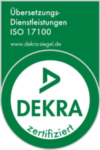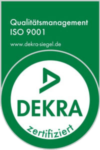
Just as with written translations, interpreting is also becoming increasingly important in international communication, especially in the business sector. As a translation company based in Essen, Kocarek GmbH provides professional translation services to its clients in the region. Professional interpreting services are required not only for tours of industrial facilities, contract negotiations, and training courses, but also for international conferences, congresses and trade fairs. Only then can the smooth exchange of information between participants be facilitated. We therefore offer our customers professional support from our interpreters. We help you select the appropriate form of interpretation – consecutive, simultaneous, or whispered interpreting – and will also be happy to provide the necessary technology.
For an interpreting assignment to be successful, it is necessary for the interpreter to be well prepared. It is important, for example, for the special technical vocabulary and proper names to be known in advance, so that the interpreter can prepare properly for the assignment. In the case of complex subjects or negotiations, the interpreter additionally familiarises themselves with the necessary background knowledge. If requested, the interpreter can also visit the location, or plan the proceedings together with the organiser.
Through the use of professional interpreting systems, interpreting assignments can be organised more effectively today, provided that all of the participants are familiar with the technology and all the necessary boundary conditions are fulfilled.
Consecutive interpretation is the oldest type of interpretation. The interpreting is performed with a delay. This generally takes the form of the interpreter making notes where necessary during the presentation, and formulating their translation on the basis of these notes. The translation should then contain only the most important information, i.e. it should be summarised and well structured. This is particularly important, because this type of interpreting significantly extends the presentation time for the listener, and can become tiring. The individual text passages that the interpreter translates may be of different lengths with this interpreting variant, but always cover a longer section with related content. Consecutive interpreting includes two types of interpreting: unilateral and bilateral interpreting. With unilateral interpreting, the interpreting takes place only in one language direction, and the text segments to be interpreted can be up to ten minutes long. With bilateral interpreting, by contrast, which is also known as liaison interpreting, the interpreter translates in both language directions. The interpreter thus facilitates the communication between two dialogue partners, such as is the case in negotiations. The text passages are typically shorter here than for unilateral interpreting, such that the interpreter predominantly translates from memory and only rarely uses notes. Consecutive interpreting is mostly used at special occasions, bilateral meetings or cultural events.
The relatively young process of simultaneous interpreting, by contrast, is characterised by the translation taking place almost simultaneously with the source text. The term “simultaneous” refers here not to the time frame, but to the fact that the interpreter is performing two activities at the same time, i.e. listening and speaking. There are various types of simultaneous interpreting, e.g. booth/microphone interpreting, relay interpreting, and whispered interpreting. The most widespread is booth/microphone interpreting, where multiple interpreters sit in a soundproof booth and listen to the speakers via headphones. The interpreting takes place almost simultaneously here, and is transmitted to the headphones of the conference participants by microphone. Since this type of interpreting requires high concentration and is hard work for the voice, the interpreters work in teams of at least two persons, who alternate at certain intervals. In relay interpreting, as the name implies, the interpreting process utilises a relay system. This means that, in this case, the interpreter translates from a comparatively rare international language into a common conference language. The interpretation is then used by other interpreters as the source text for their own translations. Alongside booth/microphone interpreting and relay interpreting, there is also whispered interpreting, also known as chochotage (from the French, chochoter, meaning “whispering”). This form of simultaneous interpreting originally managed without technical aids, because the interpreting would be for a maximum of two people. In the traditional variant, the interpreter sits between or behind their listeners, and whispers the translation to them. This type of interpreting is very exhausting for the voice, and is thus only possible for a limited time. Whispered interpreting now also utilises modern wireless microphones and remote receivers. In this case, the simultaneous interpreter sits close to the corresponding group and translates from the source language into the target language by whispering into the microphone.
Do you require further information on the subject of interpreting? Ask us! We guarantee we have the right interpreting solution for you!
Get your individual quotation:
We will give you a free quotation, with no obligation on your part. Simply send us the text, or a description of the service required.
Data upload
Are your files too large to send by email? Then you will get access to the secure in-house Kocarek Cloud.

We are certified under the international standard for translation services ISO 17100.


We are certified under the international quality management standard ISO 9001.






